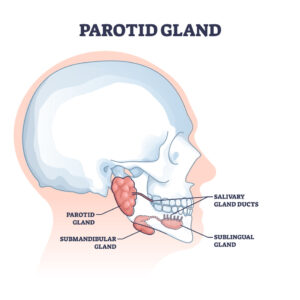Salivary glands produce saliva that lubricates the throat and the mouth. Saliva moistens the mouth aiding in food digestion and protection from tooth decay. There are major and minor salivary glands around the inner linings of the mouth, cheeks and lips. The three main salivary glands are the submandibular gland (submaxillary gland), parotid gland and sublingual glands. Several disorders can affect the glands ranging from tumours to infections which can be acute, recurrent or chronic.

Causes of salivary gland disorders
Different problems can interfere with the function of the salivary glands, and the most common include:
Bacterial Infection/sialadenitis
They are a common salivary gland disorder, and they create a painful tender lump in the gland and pus that drains into the mouth. Sialadenitis is often a result of:
- Low amounts of water in the body
- Allergies
- Smoking
- Infected lymph nodes
- Poor oral hygiene
- Autoimmune diseases
- Chronic illness
- Blockage from salivary duct stones
Obstruction
A blockage causes a decrease in the salivary flow due to small constrictions or twists in the ducts. The ducts drain saliva into the mouth. One cause of obstruction is Sialolithiasis. These are stones that are build-ups of crystallised saliva deposits. The salivary stones block the flow of saliva causing pain and enlargement of the gland. If the blockage remains untreated, it causes salivary gland infection. It is common in submandibular glands and less common in the parotid glands. It is likely to occur if you are dehydrated, have gout or are taking medication that decreases saliva production.
Viral infection
Viruses cause enlargement in both parotid glands. Mumps is one of the viral diseases that is highly contagious and common in children. It is characterised by pain, oedema and otalgia. Human Immunodeficiency virus presents with enlargement of one or more of the major salivary glands, and involves multiple low-attenuation cysts. Other viruses that cause salivary gland swelling include:
- Cytomegalovirus(CMV)
- Epstein-Barr virus (EBV)
- Coxsackievirus
- Flu virus
- Parainfluenza
Tumour
They present as a growth in the cheek, submandibular area, lips, parotid, palate and floor of the mouth. Benign tumours manifest as painless, slow-growing and asymptomatic masses. Tumours that affect the glands include Warthins and pleomorphic adenomas. Malignant tumours are rare, but you should seek further investigation if you :
- Have a history of skin cancer, radiation or Sjögren’s syndrome
- Suffer fixation to the skin
- Experience rapid increase in the size of the swelling
- Have an ulceration of the Mucosa
Salivary gland malfunction
This involves low saliva production causing dry mouth(xerostomia). Certain conditions can decrease saliva production, for example:
- Taking antidepressants, antipsychotics, antihistamines, sedatives, diuretics and antiparkinson drugs
- Chemotherapy or radioactive iodine
- Infections like HIV
- Diseases like rheumatoid arthritis
Symptoms of salivary gland disorders
Symptoms differ from person to person and depend on type of disorder and the glands affected. Different disorders have distinct symptoms, but the following are the general ones:
- Fever and pain
- Dry mouth
- Swelling of the face, neck or under the tongue
- Foul taste in the mouth
- Difficulty opening your mouth
Diagnosis
Doctors recommend testing based on medical history and a physical exam. A medical practitioner may recommend blood tests like inflammatory markers, FBC, viral serology, and salivary antibody testing.
To diagnose salivary gland obstruction, the doctor may order ultrasounds and X-rays to identify the exact location of the blockage and its cause. Medical experts are embracing newer techniques like endoscopy to diagnose obstructions.
For tumours or stones, the specialists recommend a CT scan or MRI to get a detailed analysis of the structure, functionality and anatomy of the gland. To determine whether the mass is cancerous, the doctor uses a fine needle aspiration biopsy for further analysis.
Treatment of salivary gland disorders
Treatment is either medical or surgical, depending on the disorder and its advancement. If the cause of salivary disorders is an underlying disease, doctors will treat the primary disease first.
For dry mouth disorder, you can keep the mouth moist by using a special mouthwash or salty water.
Antibiotics and extra fluids help in treating bacterial infections. On the other hand, viral infections are treated by antiviral medication, managing the fever, increasing fluids intake and bed rest. If there is an abscess, the doctors may drain it.
Treating a salivary gland mass involves surgery to remove the abnormal tissue or the gland. For cancerous masses, you require radiation treatment to kill the cancerous cells. Patients with chronic salivary gland infections can be treated through surgical removal. Parotidectomy is the removal of the parotid gland, and submandibular sialadenectomy is the removal of submandibular gland.
Prevention of salivary gland disorders
Maintaining good oral hygiene, avoiding smoking and alcohol and staying hydrated may reduce the risk of a salivary disorder. You should:
- Sip fluids throughout the day
- Chew sugarless gum
- Brush your teeth twice a day
- Have dental cleaning twice a year
- It is important to consult medical professionals when and if you have symptoms that do not resolve in a week or have difficulties eating.






